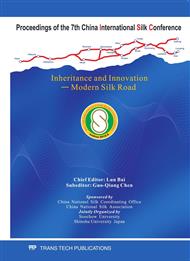p.3
p.8
p.13
p.19
p.25
p.30
p.36
p.41
p.46
Separation and Identification of Proteins Related to Fruits Ripening in Mulberry (Morus alba)
Abstract:
To elucidate the physiological mechanism of mulberry fruit ripening in protein level, differential proteome expression of mulberry fruits was analyzed by using 2-DE and mass spectrometry in different ripening stages, green ripe stage(G), half ripe stage(R) and pan ripe stage(P). A mulberry cultivator, “Da10” was used as experimental material. The results showed that separation of proteins with 2-DE were significantly improved by using phenol/SDS buffer for protein extraction. 441, 222, 328 protein spots were detected respectively in ripening stage G, R and P. Among them, differential expression of 31 proteins was more than 2-fold and 6 proteins were stage-specific expression. 8 differential proteins were identified by MALDI-TOF/TOF MS analysis and database search, which were photosynthesis related proteins (ribulose bisphosphate carboxylase/oxygenase activase and ribulose bisphosphate carboxylase small subunit), stress related protein (18kD winter accumulating protein), glucose metabolism related protein (cell wall invertase)and so on, suggesting that these proteins may play the specific physiological role in mulberry fruits ripening.
Info:
Periodical:
Pages:
25-29
Citation:
Online since:
January 2011
Authors:
Price:
Сopyright:
© 2011 Trans Tech Publications Ltd. All Rights Reserved
Share:
Citation:


